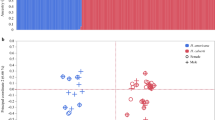Abstract
We present results deriving from the inception of an investigation (involving 4,000 scored matings) into the development of discriminatory behavior inDrosophila paulistorum. We examined two complementary situations for their effects on mating behavior: physical isolation (seclusion) beginning at each of six developmental stages and exposure to heterosemispecifics during all preadult stages (mixed culturing). Preadult seclusion at certain stages decreased sexual isolation between three of four semispecific pairs. Seclusion effect, or lack thereof, varied with semispecies and with the stage at which seclusion was imposed: the earlier the stage at which seclusion was initiated, the more drastic the effect. In contrast, mixed culturing increased sexual isolation between the one pair of semispecies that was tested.
Similar content being viewed by others
References
Carson, H. L., and Templeton, A. R. (1984). Genetic revolutions in relation to speciation phenomena: The founding of new populations.Annu. Rev. Ecol. Syst. 15:97–131.
Dobzhansky, Th. (1970).Genetics of the Evolutionary Process, Columbia University Press, New York.
Ehrman, L. (1989). Effects of lifelong experience on the rare-male mating advantage inDrosophila pseudoobscura.Behav. Genet. 19:755–756.
Ehrman, L. (1990). Developmental isolation and subsequent adult behavior ofDrosophila pseudoobscura.Behav. Genet. 20:609–615.
Ehrman, L., and Powell, J. (1982). TheDrosophila willistoni species group. In Ashburner, M., Carson, H. L., and Thompson, J. N., Jr. (eds.),The Genetics and Biology of Drosophila,Vol. 3b, Academic Press, New York, pp. 193–225.
Ehrman, L., Somerson, N., and Gottlieb, F. J. (1986). Reproductive isolation in a neotropical inect: Behavior and microbiology. In Huettel, M. (ed.),Evolutionary Genetics of Invertebrate Behavior: Progress and Prospects, Plenum, New York, pp. 97–108.
Elens, A. A., and Wattiaux, J. M. (1964). Direct observation of sexual isolation.Dros. Info. Serv. 39:118–119.
Eoff, M. (1973). The influence of being cultured together on hybridization betweenDrosophila melanogaster andDrosophila simulans.Am Nat. 107:247–255.
Gilbert, D. G., and Starmer, W. T. (1985). Statistics of sexual isolation.Evolution 39:1380–1383.
Koepfer, H. R., and Fenster, E. (1991). Asymmetrical mating patterns between geographic strains ofDrosophila mercatorum. A test of the Kaneshiro hypothesis.Evolution 45:455–458.
Lambert, D. M. (1984). Specific-mate-recognition systems, phylogenies and asymmetrical evolution.J. Theor. Biol. 109:147–156.
Lambert, D. M., and Paterson, H. E. H. (1984). On bridging the gap between race and species: The isolation concept and an alternative.Proc. Linn. Soc. N.S.W. 107:501–514.
Malogolowkin-Cohen, C., Simmons, A. S., and Levene, H. (1965). A study of sexual isolation between certain strains ofDrosophila paulistorum.Evolution 19:95–103.
Markow, T. A. (1991). Sexual isolation among populations ofDrosophila mojavensis.Evolution 45:1525–1529.
Markow, T. A., Quaid, M., and Kerr, S. (1978). Mating experience and competitive courtship success inDrosophila melanogaster.Nature 267:821–822.
Maxwell, A. E. (1961).Analyzing Qualitative Data, Halsted Press, John Wiley and Sons, New York.
Muller, H. J. (1942). Isolating mechanisms, evolution and temperature.Biol. Symp. 6:71–125.
O'Hara, E., Pruzan, A., and Ehrman, L. (1976). Ethological isolation and mating experience inDrosophila paulistorum.Proc. Natl. Acad. Sci., USA. 73:975–976.
Pruzan, A. (1976). Effects of age, rearing and mating experiences on frequency dependent sexual selection inDrosophila pseudoobscura.Evolution 30:130–145.
Pruzan, A., and Ehrman, L. (1974). Age, experience, and rare male advantages inDrosophila pseudoobscura.Behav. Genet. 4:159–164.
Pruzan, A., Applewhite, P., and Bucci, M. (1977). Protein synthesis inhibition altersDrosophila mating behavior.Pharm. Biochem. Behav. 6:355–357.
Pruzan, A., Ehrman, L., Perelle, I., and Probber, J. (1979). Sexual selection,Drosophila age and experience.Experientia 35:1023–1024.
Richmond, R., and Ehrman, L. (1974). The incidence of repeated mating in the superspeciesD. paulistorum.Experientia 30:489–490.
Ringo, J. M., Dowse, H. B., and Lagasse, S. (1986). Symmetry versus asymmetry in sexual isolation experiments.Evolution 40:1071–1083.
Siegel, S. (1956).Nonparametric Statistics for the Behavioral Sciences, McGraw-Hill, New York.
Siegel, R. W., Hall, J. C., Gailey, D. A., and Kyriacou, C. P. (1984). Genetic elements of courtship inDrosophila: Mosaics and learning mutants.Behav. Genet. 14:383–410.
Spieth, H. T., and Ringo, J. (1983). Mating behavior and sexual isolation inDrosophila. In Ashburner, M., Carson, H. L., and Thompson, J. M., Jr. (eds.),The Genetics and Biology of Drosophila, Academic Press, New York, pp. 223–284.
Tompkins, L., and Hall, J. C. (1981). The different effects on courtship of volatile compounds from mated and virginDrosophila females.J. Insect Physiol. 27:17–21.
West-Eberhard, M. J. (1983). Sexual selection, social competition, and speciation.Q. Rev. Biol. 58:155–183.
Zar, J. H. (1974).Biostatistical Analysis, Prentice-Hall, Englewood Cliffs, N.J.
Zawistowski, S., and Richmond, R. C. (1985). Experience-mediated courtship reduction and competitive for mates by maleDrosophila melanogaster.Behav. Genet. 15:561–569.
Zawistowski, S., and Richmond, R. C. (1987). Experience mediated courtship reduction ofDrosophila melanogaster in large and small chambers.J. Comp. Psychol. 101:90–93.
Author information
Authors and Affiliations
Additional information
This research was partially supported by research awards from the Whitehall Foundation (to L. Ehrman), PSC-CUNY (662176 to H. R. Koepfer), and The Conservation Agency through a grant from the Falconwood Corporation (to H. R. Koepfer).
Rights and permissions
About this article
Cite this article
Kim, YK., Ehrman, L. & Koepfer, H.R. Developmental isolation and subsequent adult behavior ofDrosophila paulistorum. I. Survey of the six semispecies. Behav Genet 22, 545–556 (1992). https://doi.org/10.1007/BF01074307
Issue Date:
DOI: https://doi.org/10.1007/BF01074307




